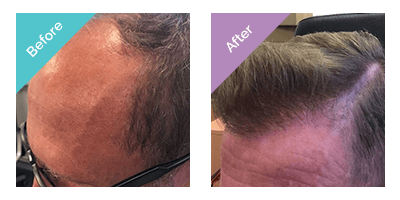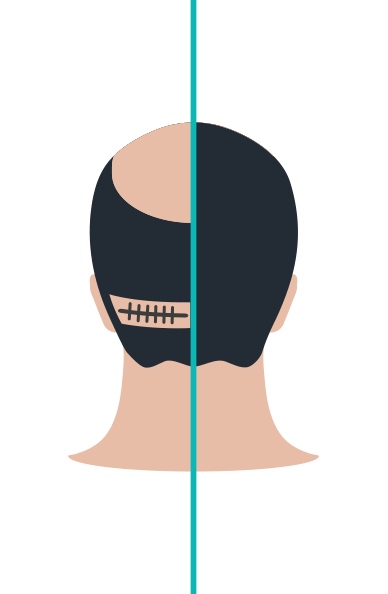Scars on the scalp can make many people feel self-conscious, especially if they’re large or wide. One way to camouflage these is by undergoing hair transplant scar removal surgery.
In this,follicular unit extraction (FUE) will redistribute the hair follicles over the scar so that it’s not visible, even when the hair’s short.
Overview Of Hair Transplant Scar Removal
Before follicular unit extraction, there were different techniques for hair restoration. Most of these left permanent, visible scars on the scalp.
Follicular Unit Transplant (FUT)
Although not as popular anymore, decades ago, follicular unit transplantation (FUT) was the technique used for performing hair restoration.
It was a significant improvement from the other transplantation techniques, but one of the biggest concerns about FUT was the linear scar.
To extract individual donor hair follicles, a strip of skin was removed, usually from the back, after which it was sutured.
The length of this scar tissue varied between patients, depending on the number of hair follicle grafts they needed. In some instances, the scar tissue extended from ear to ear.
Those who had this surgery had permanent scarring. The appearance of the scar also changed with age as skin laxity (loose skin) became a concern among older hair transplant patients.
Scalp Reduction Surgery
This was another technique for restoring hair in people with androgenetic alopecia.
Essentially, the skin containing hair follicles that had been affected by the hormone dihydrotestosterone (DHT) was removed. However, the patients were left with a very prominent scalp reduction scar.
The appearance of this scar kept changing as the patient’s skin lost elasticity with age.
Hair Plugs
A hair plug with a diameter of 3-4mm was once excised from the donor area (back and sides of the scalp).
It contained 5 or more follicular units (not hair – for reference, the latest techniques only remove 1 unit at a time). However, not only did this look unnatural, but it also left significant scarring on the donor site.
Please note that we don’t provide hair plugs in Turkey. Instead, we do hair transplants because of their natural results.
FUE for Scar Removal
To address the scarring concerns from old hair transplantation techniques and other instances, scar removal surgery is done.
It uses the follicular unit extraction (FUE) technique to transplant hair follicles into the scars.
What Is The Cost Of Hair Transplant Scar Repair Surgery?
The cost of hair transplant scar removal surgery is usually lower in Turkey than in the UK or European countries by 3-5 times.
It is because of the lower fees of Turkey hair transplant surgeons/technicians, operating rooms, and clinical laboratories.
Overall, the cost of healthcare infrastructure in Turkey is also lower. And the exchange rates also help foreigners get affordable treatments.
Other services are offered with the surgery as well, including hotel, transfers, translators, and aftercare.
Who Can Have Hair Transplant Scar Removal Surgery & Why
You are a suitable candidate for this treatment if you have:
- Linear scars from FUT hair transplant
- Scars from hair plugs
- Scalp reduction scar
- Scarring alopecia
- Burn injury
- Physical trauma (accidents, injuries, falls, natural disasters)
For hair transplant scar removal, the surgeon assesses the thickness of the scar(s).
If the scar is hypertrophic because of the overproduction of collagen, the blood supply will be poor.
Due to the low nutrient supply, the hair follicles will not survive. Similarly, if the scar is atrophic because of the underproduction of collagen, the hair grafts will not survive.
Keep in mind if you have keloid scarring or are susceptible to forming keloid scars, the restoration surgery cannot take place.
In addition, if you have an active flare-up on the scalp from an inflammatory disease, scar revision surgery cannot take place.
Am I Suitable For Hair Transplant?
What To Think About Before You Have Hair Transplant Scar Removal Surgery
Before undergoing the treatment, ask the surgeon/practitioner the following questions:

- What is your specialization, qualification, training, and experience?
- How many procedures have you performed to conceal scars, and for how long?
- What are the possible complications that can arise from this kind of treatment? How did you deal with these complications in the past?
- How well can the treatment hide hair transplant scars, hypertrophic/atrophic scars, burn injuries, and/or scars from physical trauma?
- Can you show me the results of a previous patient who underwent a similar procedure? Is it possible to meet them?
- What are the overall patient satisfaction rates with scar removal surgery?
How Best To Prepare For Hair Transplant Scar Removal Surgery
To prepare for your scar removal surgery, you need to do the following:
- Stop taking blood thinners around 2 weeks before the surgery. You also shouldn’t take any supplements 1 week before the hair transplant.
- Refrain from drinking alcohol or doing recreational drugs at least 3 days before the surgery.
- The transplant surgeon will need written consent from your cardiologist if you are a heart patient.
- Do not shave, cut, or trim your hair 2 weeks before the hair restoration surgery since the surgeon needs to analyse the natural hair growth pattern in the recipient area.
- Make sure you’re not wearing any hair systems before surgery, and wash out all hair products.
- Inform the surgeon about your scalp health and any active treatments that you’re on.

What’s The Procedure For Hair Transplant Scar Repair?

Before performing the surgery, the surgeon will assess the nature of the scar as it will impact the surgical outcome of the hair scar repair procedure:
- Is it raised, flat, or depressed?
- What’s the size/shape of the scar?
- How did the patient get the scar?
- Was the wound sutured for healing, or did self-healing take place?
In this way, they can figure out how many grafts are necessary to conceal the scar. Moreover, through this, they can predict the survival rate of the grafts.
They will make a further assessment of this at the time of implantation by observing the amount of bleeding that occurs.
After that, the surgeon will extract hair follicles from the donor area using a punch tool.
Since most FUT scars are on the back of the scalp, the donor site, in this case, may be the sides of the scalp or surrounding hair.
This will be shaved, after which local anaesthesia will be given to the patient.
The individual hair follicles extracted are stored in a solution. And then, incisions are made to implant hair in the scar tissue. The hair transplant repair itself takes 2-3 hours.
It may take 6-8 hours on average if you are having surgical procedures for scar tissue and hair loss in other areas of your scalp.
Book A Free Consultation With Our Patient Consultants
We offer free consultations for patients across the UK & Ireland, so you can discuss your individual requirements with our specialists. Book A Free Consultation With Our Patient Consultants Today.
Recovery And Results Of Hair Transplant Scar Removal Surgery
After undergoing the hair transplantation surgery, you can return to your hotel on the same day. There will be a light dressing on your donor area.
However, the recipient area is exposed. Do not try covering it with a hat or scarf. Meanwhile, stay out of the sun.
You will experience some temporary side effects soon after the surgery, but they’re normal and expected. Be extra careful around hair transplants in the scar tissue.
It is possible for your hair to fall out a few weeks after the surgery due to shock loss. But normal hair growth after scar revision should take place after 3-4 months.
For complete results, you’ll have to wait for 12-18 months.
Aftercare For Hair Transplant Scar Repair
It is important that you closely follow the aftercare instructions of the surgeon.
That’s because the poor blood supply to the scar tissue makes it even more vulnerable to damage.
Be careful when you’re moving or lying down to not hit your head anywhere.
You also need to avoid vigorous physical activity for a month after the surgery and not play contact sports.
Gently wash the hair grafts with the lotion and shampoo provided by the surgeon.
When washing the scalp, do not use pressurized water.
Other than that, drink lots of water and eat foods that promote healing and healthy hair growth.
Side Effects To Expect After Transplant Scar Removal
After the hair transplant repair surgery, you can experience the following side effects temporarily:
- Swelling for 7 days
- Bleeding and itching for 2-3 days
- Pain and numbness for 3-4 days
- Folliculitis and pimples after 2-3 weeks
What Could Go Wrong After Hair Transplant Scar Repair Surgery?
Since the transplanted grafts in the scar tissue are very delicate, the slightest physical trauma can displace them.
It can cause permanent damage to the grafts and will affect the outcome of the surgery.
Moreover, since blood flow to the tissue is poor, wound healing is slower. As a result, you’re at an increased risk of developing an infection.
What To Do If You Have Any Problems After Hair Transplant Scar Removal Surgery?
If you’re experiencing any post-op complications, you can reach out to the aftercare team online. It is also possible to call or email them.
You can also get in touch with your Patient Relations Specialist for advice from your surgeon.
Alternatives To Hair Transplant Scar Removal
If you’re not suitable for this surgery because of the lack of enough hair at the donor site, you can get scalp micropigmentation (SMP), informally known as scalp hair tattooing.
In this, the practitioner injects a special ink into the second layer of skin – the dermis. While doing so, they will make sure that the pigmentation mimics the natural hair follicles.
Scalp micropigmentation can create the illusion of full hair on damaged skin.
Other Procedures To Have With Hair Transplant Scar Removal
Other than concealing the FUT scar using the FUE method, you can undergo hair transplants in other areas of the scalp if you’re experiencing permanent hair loss because of different types of alopecia.
You can also consider getting platelet-rich plasma (PRP) injections after the surgery. It can improve blood circulation in the surgical areas and increase the survival rate of the grafts.
FAQ
Can I completely get rid of the hair transplant scar after the surgery?
The FUE procedure will not rid you of the significant scarring from the FUT procedure. It will only conceal it by transplanting hair in that area.
Will I have scars from the FUE procedure?
The micro punch tool leaves tiny scars after extracting hair follicles from donor areas. It is barely visible when the hair’s short but fades with time.
What is the success rate of hair transplant scar removal surgery?
Hair transplantation in damaged skin differs from transplantation in healthy skin. Graft survival depends on scarring, vascularization of the scar tissue, and the medical history of the patient. The success rate can be anywhere between 10-80%.
Will my surgeon have insurance that covers this surgery?
Yes, the surgeon performing your hair transplant scar repair surgery will have medical malpractice insurance.
Will follow-up checks for scar removal surgery be offered in the UK?
You can have a face-to-face consultation and follow-up checks at the London clinic.
Reviewed and Approved by Trichologist Yaprak Yazan.

